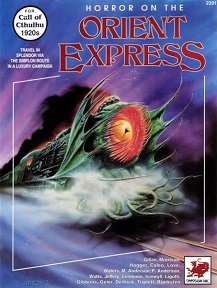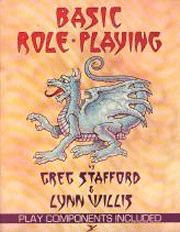
Basic Role-Playing (BRP) is a tabletop role-playing game which originated in the RuneQuest fantasy role-playing game. Chaosium released the BRP standalone booklet in 1980 in the boxed set release of the second edition of RuneQuest. Greg Stafford and Lynn Willis are credited as the authors. Chaosium used the percentile skill-based system as the basis for most of their games, including Call of Cthulhu, Stormbringer, and Elfquest.

Call of Cthulhu is a horror fiction role-playing game based on H. P. Lovecraft's story of the same name and the associated Cthulhu Mythos. The game, often abbreviated as CoC, is published by Chaosium; it was first released in 1981 and is in its seventh edition, with licensed foreign language editions available as well. Its game system is based on Chaosium's Basic Role-Playing (BRP) with additions for the horror genre. These include special rules for sanity and luck.
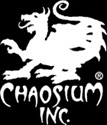
Chaosium Inc. is a publisher of tabletop role-playing games established by Greg Stafford in 1975. Chaosium's major titles include Call of Cthulhu, based on the horror fiction stories of H. P. Lovecraft, RuneQuest Glorantha, Pendragon, based on Thomas Mallory's Le Morte d'Arthur, and 7th Sea, "swashbuckling and sorcery" set in a fantasy 17th century Europe.

Delta Green is a contemporary era setting for the Call of Cthulhu role-playing game created by Adam Scott Glancy, Dennis Detwiller, and John Scott Tynes, a.k.a. the Delta Green Partnership, of the Seattle gaming house Pagan Publishing. The setting first appeared in a 1992 RPG scenario and revolves around a secretive organization tasked with protecting the United States from paranormal and alien threats. Delta Green combines the classic 1920s Cthulhu Mythos of H.P. Lovecraft with modern conspiracy fiction.
James Daniel Lowder is an American author, anthologist, and editor, working regularly within the fantasy, dark fantasy, and horror genres, and on tabletop role-playing games and critical works exploring popular culture.

Pelgrane Press Ltd is a British role-playing game publishing company based in London and founded in 1999. It is co-owned by Simon J Rogers and Cat Tobin. It currently produces GUMSHOE System RPGs, 13th Age, the Diana Jones award-winning Hillfolk RPG, The Dying Earth Roleplaying Game, and other related products. It publishes fiction under the Stone Skin Press imprint.

Trail of Cthulhu is an investigative horror role-playing game published by Pelgrane Press in 2008 in which the players' characters investigate mysterious events related to the Cthulhu Mythos. The game is a licensed product based on the horror role playing game Call of Cthulhu published by Chaosium, which is itself based on the writings of H. P. Lovecraft.
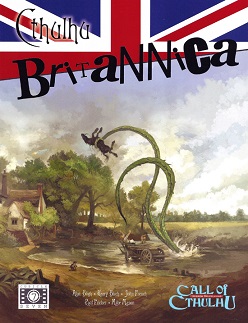
Cthulhu Britannica is a series of role-playing game supplements produced by the British game company Cubicle 7 Entertainment for use in the Call of Cthulhu role-playing game produced by Chaosium. The series allows for games to be set in the United Kingdom.
The Unspeakable Oath is a game magazine that was published by Pagan Publishing from 1990 to 2001, and later by Arc Dream Publishing starting in 2010.
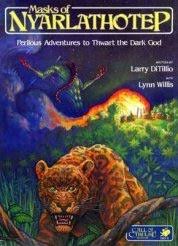
Masks of Nyarlathotep, subtitled Perilous Adventures to Thwart the Dark God, is an adventure campaign first published by Chaosium in 1984 for the second edition of the horror role-playing game Call of Cthulhu. A number of revised editions have subsequently been published. Masks of Nyarlathotep is a series of several sequential adventures set in the 1920s that take the player characters from New York, to London, Cairo, Nairobi, and Shanghai as they deal with the threat of the god Nyarlathotep. Screenwriter Larry DiTillio wrote the adventure with game designer Lynn Willis during a writer's strike. It received positive reviews in game periodicals including Casus Belli, The Space Gamer, White Dwarf, Different Worlds, and Dragon, and is considered to be one of the best roleplaying adventures of all time.

Cthulhu by Gaslight is a horror tabletop role-playing supplement, written by William A. Barton, with art by Kevin Ramos, and first published by Chaosium in 1986. This supplement provides information on role-playing in an alternate setting of Victorian England of the 1890s for Call of Cthulhu. An expanded second edition was published in 1988, and a third edition was published in 2012. It won an Origins Award and received positive reviews in game periodicals including White Dwarf, Casus Belli, Different Worlds, Space Gamer/Fantasy Gamer, The Games Machine, Games International, and Dragon.

In the Shadows is an anthology of adventures published by Chaosium in 1995 for the 5th edition of the Lovecraftian horror role-playing game Call of Cthulhu.

The Golden Dawn is a Horror Fiction supplement published under license by Pagan Publishing in 1996 for Chaosium's horror role-playing game Call of Cthulhu.

The Complete Masks of Nyarlathotep is an adventure campaign published by Chaosium in 1996 for the horror role-playing game Call of Cthulhu; it is the third edition of the adventure campaign Masks of Nyarlathotep originally published in 1984. It is a series of several sequential adventures set in the 1920s that take the player characters from New York, to London, Cairo, Nairobi, and Shanghai as they deal with the threat of the god Nyarlathotep. The Complete Masks of Nyarlathotep is a revised and expanded version of the original adventure scenario with additional material by new authors. It won an Origins Award and received positive reviews in game periodicals including Arcane and Dragon.
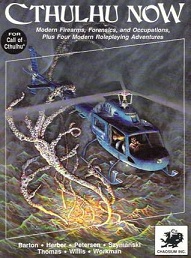
Cthulhu Now is a supplement published by Chaosium in 1987 for the horror role-playing game Call of Cthulhu.

The Great Old Ones is a horror tabletop role-playing adventure, by Marcus L. Rowland, Kevin A. Ross, Harry Cleaver, Doug Lyons, and L.N. Isinwyll, with art by Tom Sullivan, and published by Chaosium in 1989. The Great Old Ones contains six adventures for Call of Cthulhu. It won the Origins Award for "Best Roleplaying Adventure of 1989".

Fatal Experiments, subtitled "Three Investigations into the Sinister and Macabre", is a collection of three adventures published by Chaosium in 1990 for the horror role-playing game Call of Cthulhu, itself based on the works of H.P. Lovecraft.
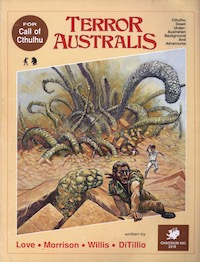
Terror Australis is a supplement published by Chaosium in 1987 for the horror role-playing game Call of Cthulhu, itself based on the works of H. P. Lovecraft. It was written by Penelope Love, Mark Morrison, Lynn Willis, Larry DiTillio, and Sandy Petersen, and is intended to be used as a sourcebook for adventures in Australia in the 1920s. It received positive reviews in game periodicals including White Dwarf, Casus Belli, and Dragon. A revised and expanded second edition was published in 2019, which won two ENnie Awards.
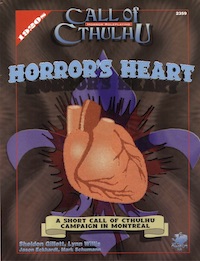
Horror's Heart is an adventure campaign published by Chaosium in 1996 for the 5th edition of the horror role-playing game Call of Cthulhu.

Kingsport: The City in the Mists is a supplement published by Chaosium in 1991 for the horror role-playing game Call of Cthulhu that describes a mysterious Massachusetts city, itself based on the work of H.P. Lovecraft.
